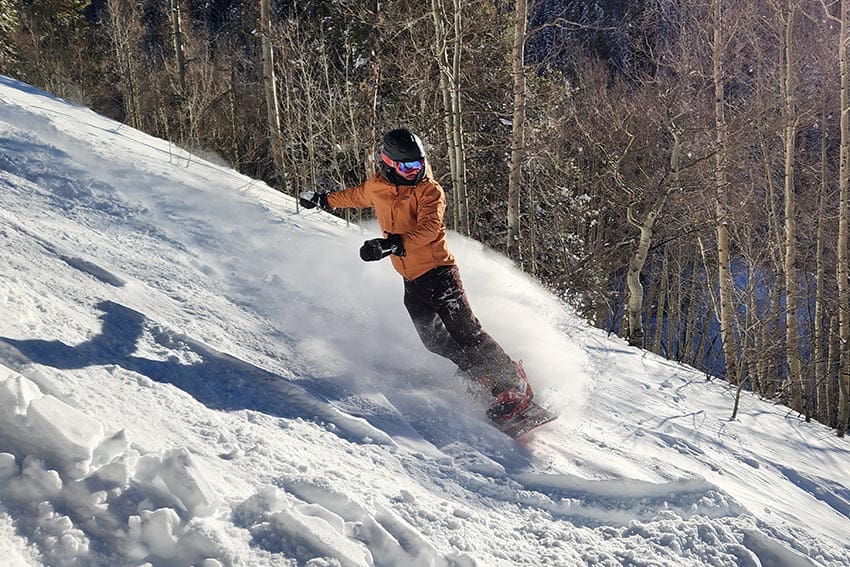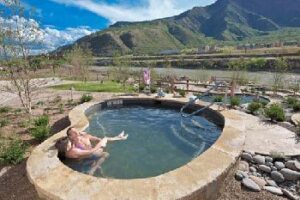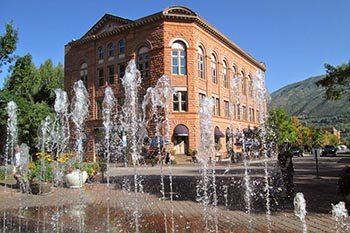
Vail: Colorado’s Famous Resort
By Alan Wechsler
In late winter of 1957, Colorado resident and mining prospector Earl Eaton led his Army buddy Pete Seibert up an unnamed mountain ridge halfway between Denver and Grand Junction. Founded by a ranching family named Vail, the area was nothing but sheep farms and an old water stop on the Southern and Pacific Railroad.

The two, both veterans of the Army’s famed 10th Mountain Division during World War II, were looking for a place to build Colorado’s next great ski mountain.
They skinned up the 4,000-foot slope for nearly seven hours until they reached the top. And Siebert saw, for the first time, the huge, open back bowls that would one day make Vail famous.
His reaction was not unlike the famous words Brigham Young uttered when the Mormon pioneers first laid eyes on the Great Salt Lake valley: this is the place.
Vail opened for skiing five years later, and today is one of the largest ski resorts in North America.
Last winter, I spent a few days here, staying with friends at what could be one of the oldest residential homes in the valley: a ski chalet built not long after after the resort opened.
Getting to Vail
Vail is about 100 miles west of Denver. It’s a longer drive than the Summit County resorts of Keystone, Copper, Arapahoe Basin and Breckenridge, and requires crossing Vail Pass, which sometimes closes during bad weather.
While we drove to get here, renting a car is not necessary. You can hire a shuttle service like Eagle Vail Express or Epic Mountain Express, which will run around $80 to $170 per leg. It’s also possible to fly into nearby Eagle, but a lot more expensive.
Our ski house (it goes at $3,000 per night if you’re interested) was only a few minutes from Vail Village, a base area of high-end shops, restaurants and bars. There’s plenty of lodging here, including Sonnenalp Vail, The Lodge at Vail, and Tivoli Lodge, though there are many others. Prices range from $300 to more than $1,000 per night, depending on hotel quality and distance from the lifts.

Better deals can be found further from the resort. Note that many off-site residences bus to Lionshead, the base village located to skier’s far left – a fine place to start, but not as centrally located on Vail’s vast slopes as the main village is.
Coming for the day? Expect to pay hefty parking fees, although you can park for free in the evenings.

Vail is also expensive to ski. Passes cost as much as $270 per day, although advanced and multi-day tickets are cheaper. Anyone planning to spend more than a couple of days here would be well-served to pick up an Epic Pass, Vail’s signature ski pass, which grants holders access to dozens of resorts around the country. But make sure you buy it early, as the price goes up in the fall and sales are cut off when ski season begins.
Hunter Mountain and Vail
For me, a New York resident, the Epic Pass already granted me unlimited use of Hunter Mountain in New York and Mt. Snow, Okemo and Stowe in Vermont. Free skiing at Vail was quite the value-added.
Our timing during the weak snow winter of 2023-24 was serendipitous. After a month of little snow, we arrived in mid-January to find a storm in full swing. All that snow made for some sketchy driving west of Denver, and at one point we were stopped for an hour while waiting for highway workers clear the road.
After arriving at our host Rob’s home by 9 a.m., we didn’t waste any time. We jumped into our ski clothes and walked to the nearby Gondola One to head up the mountain. Powder is fleeting, and when the skiing is this good you don’t want to waste even a moment.

Exploring the Mountain
As mentioned, Vail is vast. The gondola brought us to the busy Mid-Vail area, which in turn gave us access to the Mountaintop Express and Wildwood lifts that go to the top of the ridge. Expert skiers, we headed to the steep sides of the North Rim, where some short cliffs guarded a stash of powder. It was still coming down, so we spent much of the day exploring the front side. In three days of weekday skiing, we rarely waited on line, although weekends are a much busier experience.
Skiers of all abilities will find a multitude of terrain throughout Vail. Prime and Riva Ridge are two black-diamond, top-to-bottom runs that date back to the mountain’s opening. Easier blue terrain is found at the top of Mountaintop Express and to skiers left of the Wildwood summit area.

Beginner trails, on the other hand, are generally traverses that switch back and forth between the harder routes. No matter what your skill level, you won’t be bored.
After a few hours, we took a short break at Buffalo’s, one of Vail’s many excellent summit restaurants. It was a bit crowded here, but the $18 brisket grilled cheese and tomato soup cup were excellent (Epic Pass holders get a discount).
After lunch, we headed down the back bowls. There are a half-dozen of these incredible open skiing fields: Sun Down, Sun Up, China, Tea Cup, Mongolia, Siberia. There’s not a lot for beginners here, but skiing these bowls is a quintessential Vail experience.
The Back Bowls of Vail
Unfortunately, they are not easy to ski during a snowstorm. The lack of trees during a whiteout makes visibility impossible, and it’s hard to tell up from down. At one nervous point, we wound up skiing to the edge of some small cliffs, and we carefully made our way down a weakness between airy perches, not sure where we were headed until we reached the bottom.
Still, there are bands of trees one can follow during times of low visibility. During our visit, only the top few hundred feet were clouded in, making for better skiing (and lots of remaining powder) as we made our way downhill.
There is much to see and many lines to take. This was my third visit to Vail, and I have still not made it to Siberia and Mongolia bowls, the lower-angle routes at skier’s far left. But our main interest was getting to Blue Sky Basin, to me the crown jewel of Vail.

Blue Sky opened in 2000, on a ridge opposite the Back Bowls. It was a controversial decision, with critics saying it could endanger lynx habitats.
In response, arsonists burned down what was then a new summit restaurant called Two Elk Lodge (it’s since been replaced by an even bigger building, and is one of the most majestic sites on the mountain – definitely worth a visit, especially on busy days, because there’s PLENTY of tables).
To get to Blue Sky, take China or Tea Cup bowl, which funnels skiers to a crossover to the Skyline Express lift. Blue Sky consists of several ridges and drainages, with lots of open woods skiing between the blue and black runs, and retains its wilderness feel.

Blue Sky is the last place on the mountain to open after a storm, as ski patrol clears away potential avalanches. We got here shortly after the ropes dropped, and found run after run of three-foot-deep powder lines in the woods. Much of the basin was still closed when we headed back. But with plenty more snow in the forecast, we knew it would be a few more days before we would gain access.
Eating, Drinking and Entertainment
Of course, skiing is only part of the experience of Vail. In the evenings, we wandered down to the village. We spent one night at Pazzo’s Pizza, which offers reasonably-priced pies in a fast-casual environment. Other values in the village include Los Amigos and El Sagundo for Mexican, Almresi for German fare, and Roots and Flower for wine.
There are plenty more places at the Lionshead base, including gelato at the Rimini Cafe, where I was supposed to meet a friend for an apres ski but got confused about which base to go to. Fortunately, free buses move frequently from one area to the other.
I caught up with my friend at the extensive (and free) Snowsports Museum at Vail Village. The museum, open until 6 p.m. so you can see it after your ski day, is well worth an hour. The exhibits explore the history of the mountain as well as displays on changes in ski technology and clothing styles. My favorite part was a video showing models posing in ski clothing from the 1920s to the 1990s.
If you have even more time, there’s an excellent 45-minute video about the 10th Mountain Division, which trained an hour to the east at Camp Hale.
Both base areas having a thriving nightlife, if you have any energy left to stay up that late. You can often find free concerts, lectures, and other events. Further afield, there are many other pubs playing live music into the night, which you can get to by private vehicle, bus or car service.
The Minturn Mile
For this visit, I was glad to be with Vail veterans to show me some of the mountain’s lesser-known attributes. For instance, on front-side there’s a terrific little natural halfpipe called Hairbag that’s hidden away off the Sourdough Trail, a great run if you like tight, narrow expert runs. Cady’s Café, right off Mid-Vail, offers a similar experience, albeit with a steep headwall at the bottom (take that double-black diamond designation seriously).
For expert skiers, the East Vail Chutes are the closest Vail gets to extreme (and out-of-bounds) terrain. For those it’s best to go with someone who knows the area, because some of those chutes end in icy cliffs, and avalanche gear is a necessity.

My favorite (not-so) secret was a trip down the Minturn Mile, a side-country journey that brings skiers to the nearby hamlet of Minturn. For this you need a car already spotted at the bottom (or a preplanned pick-up) and a bit of fortitude at the end of the day.
The “mile” (actually three) takes skiers from the top of Vail at 11,000 down to 8,000 feet. There are several ways to enter. Our group went through a backcountry gate near the top of the Wildwood summit area.
We skied along the area boundary ropes before cutting down into slope after slope of deep, untouched powder. Eventually, the terrain funneled us into a ski track that took us across frozen beaver ponds and down the tight “luge run” – not a trail I’d want to take in icy conditions – finally popping out at the edge of Minturn.
If interested in this route, it would be best to hook up with someone who’s done it before. It is possible to wander down the wrong drainage and get trapped, or otherwise lost on the way down. Avalanches, though rare on this relatively low-angle terrain, have also occurred.
Once in Minturn, we walked down the street and stashed our skis outside the historic Minturn Saloon for a well-earned aperitif. If you’re a sports fan, it’s worth a visit to see autographed pictures of some of the legends of the 20th Century, as well as a framed jersey once belonging to John Elway.
Afterward, we headed across the street to the Minturn Country Club. Don’t let the name fool you – it’s not a golf course but a cook-your-own-steakhouse, one of several found in Colorado ski country.
 After you take you seats, the owner comes by and explains how it works: you fetch a salad from the salad bar, cook some garlic bread on the giant grill, then go to the nearby butcher stand and pick out whatever cut you want – they range from $20 for a small strip to $74 for kobe beef. Then you take it to the grill and have at it.
After you take you seats, the owner comes by and explains how it works: you fetch a salad from the salad bar, cook some garlic bread on the giant grill, then go to the nearby butcher stand and pick out whatever cut you want – they range from $20 for a small strip to $74 for kobe beef. Then you take it to the grill and have at it.
A sign on the wall offers suggested cooking time, though I found it was way too liberal for my skinny (and now well-burnt) cut.
Our days at Vail came to a close about the same time that the snow stopped falling – perfect timing. We left the resort with sore thighs and full stomachs, and looking forward to our next visit.

Alan Wechsler is a freelance writer based in Albany, NY. His outdoor passions including skiing, bicycle-touring, rock climbing and hiking, and has traveled extensively.
- Greece’s Peloponnese Region from Corinth to Areopoli - August 20, 2024
- Portland Maine for Tasty Lobster and City Flair - August 18, 2024
- St Ives in Cornwall: The Very Bottom of England - July 31, 2024





